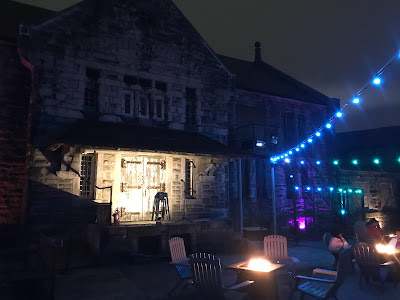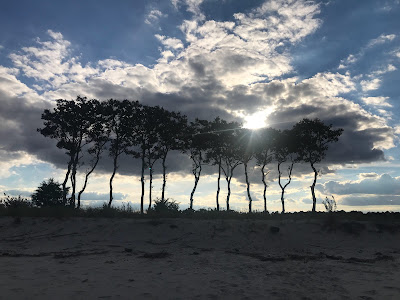We visited the John Dickinson Plantation which I've been meaning to do for a year now ever since I read about the African American burial ground being found last year, shortly after we moved to the Mid Atlantic. We were busy getting settled so we didn't visit and time got away from me.
I've read some about the plantation and knew it dated back to before the American Revolution, much further than many others in this country. Dickinson is known as the "Penman of the Revolution" but that doesn't sit all that well with me in that it's indicative of the culture of white male supremacy. It makes the plantation all about him and not the African American slaves he owned or his wife or the type of structure or the geographic locale. But yes. I get it that being a primary writer involving events that led up to the Revolution is a big deal. I get it. I am just venting in part due to the Trump era focus on "Might is Right" and lies told often enough become true for many people and outrageous lying has become commonplace among many of his followers. They want to get back to the time where white men reigned unquestioningly in this country defining freedom and liberty for themselves and not others. I was actually surprised that there wasn't a tour bus of Trump followers there wearing their garb and taking notes. Kind of.
The African American burial ground was found just over a year ago, March 9 2021 but is not available for the public to walk towards. The entire path to it is not accessible. It was found through archeological research and is thought to hold the remains of many human beings, maybe 400. That's a lot of lives, a lot of people's ancestors lying in ground unmarked and forgotten for years, maybe as far back as the 1720's. The state is currently working with community members on how to go forward. The land the burial ground was found on was acquired by the state in 2000.
 |
| The plantation faces this view, towards the St. Jones River which used to be much wider and deeper and capable of supporting boats. The rivers were to the inhabitants of the day what roads are to us now. But the St. Jones has been straightened and no longer follows the course or provides a view (to see approaching ships) along the front of the house. |
 |
| The plantation house was know as Poplar Hall and the main house was built in 1739 through 1740. |
John Dickinson grew up there and lived there off and on. He was born in 1732 and died in 1808.
The house was raided and significantly damaged in 1781 by the Brits and in 1884 a fire wiped out most everything but the bricks. Dickinson really only lived in the house a handful of years total - 1776-77 and 1781-82. I believe he lived in Wilmington, Delaware and Philly the rest of the time and is buried there though his father is buried not far from the main house, easy to see as it was done with obvious pomp and circumstance befitting a wealthy white man.
Ironically, Dickinson didn't vote in favor of the Declaration of Independence though he supported it. He thought the Colonists weren't ready to declare independence and didn't have foreign support lined up. He thought that civil disobedience would help alter British thinking and laws. Dickinson was a Quaker though he made exceptions to allow for his wealthy lifestyle and slave holdings and joined the Continental Army.
Dickinson wrote essays anonymously entitled "Letters from a Farmer in Pennsylvania" which were printed throughout the Colonies and credited in large part with uniting the white Colonists against Britain. Only Thomas Paine's "Common Sense" is given more weight. Dickinson's persona in his "letters" was as an intelligent farmer of modest means, calm, thoughtful, reasonable and moral. He was actually a wealthy Philadelphia lawyer and large landowner. In his essays he wrote convincingly of Britain's constitutional flaws and questionable legalities regarding aspects of their rule over the colonies. Dickinson explains away his detailed knowledge of laws and politics by saying he spends time reading in his own small home library. Not all that believable to me but it was very effective in it's day. And I guess a lot of "fake news" and psychological operations in today's times are also effective in accomplishing goals. History is fascinating. I wonder how current times will be framed in history 20-30 years from now?
 |
| After we left Dickinson Plantation we went to Bowers Beach for a walk. Access to South Bowers Beach is now blocked off as private property. Bummer. That is where we found a rusty old narrow single bed springs that we drug home with us last winter. |














































